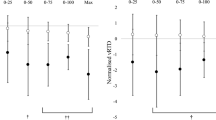Summary
The purpose of this study was to determine if the differences in anaerobic power between males and females could be accounted for by differences in body composition, strength, and neuromuscular function. A total of 82 untrained men and 99 women took part in the study. Body composition, somatotype, isometric strength, neuromuscular function were measured, and four anaerobic power tests performed. The men were significantly different from the women on all strength, power, and neuromuscular measurements except reaction time and on all anthropometric and somatotype dimensions except ectomorphy. Strength and anthropometric dimensions were similarly related to anaerobic power values within each sex. Relative fat (%fat) exerted different degrees of influence on sprint and jump performances in each sex. Removing the influence of anthropometric, strength, and neuromuscular differences by analysis of covariance reduced, but did not remove, the significant differences between the sexes. Therefore, factors other than lean body mass, leg strength, and neuromuscular function may be operating in short-term, explosive power performances to account for the differences between the sexes. The task-specific nature of anaerobic power tests and the relatively large influence of anthropometric factors on power production were confirmed.
Similar content being viewed by others
References
Beckenholdt SE, Mayhew JL (1983) Specificity among anaerobic power tests in male athletes. J Sports Med Phys Fitness 23:326–332
Bergstrom J, Harris RC, Hultman E, Nordesjo LO (1971) Energy rich phosphogens in dynamic and static work. In: Perrow B, Saltin B (eds) Muscle metabolism during exercise. Plenum Press, New York, pp 341–355
Bishop P, Cureton K, Collins M (1987) Sex differences in muscular strength in equally-trained men and women. Ergonomics 30:675–687
Bosco B, Mognoni P, Luhtanen P (1983) Relationship between isokinetic performance and ballistic movement. Eur J Appl Physiol 51:357–364
Bruyn-Prevost P de, Sturbois X (1984) Physiological response of girls to aerobic and anaerobic endurance tests. J Sports Med Phys Fitness 24:149–154
Clarke HH (1967) Application of measurement to health and physical education, 6th edn. Prentice-Hall, Englewood Cliffs, pp 66–71
Considine WJ, Sullivan WJ (1973) Relationship of selected tests of leg strength and leg power on college men. Res Q 44:404–416
Cureton KJ, Collins MN, Hill DW, McElhannon JM (1988) Muscle hypertrophy in men and women. Med Sci Sports Exerc 20:338–344
Cureton TK (1947) Physical fitness appraisal and guidance. Mosby, St. Louis, p 403
Davies BN, Greenwood EJ, Jones SR (1988) Gender difference in the relationship of performance in the handgrip and standing long jump tests to lean limb volume in young adults. Eur J Appl Physiol 58:315–320
Fox EL, Bowers RW, Foss ML (1988) The physiological basis of physical education and athletics, 4th edn. Saunders, Philadelphia, pp 674–676
Fukunaga T, Matsuo A, Yuasa K, Fujimatsu H, Asahina K (1980) Effect of running velocity on external mechanical power output. Ergonomics 23:123–136
Harrison GG, Buskirk ER, Carter JEL, Johnston FE, Lohman TG, Pollock ML, Roche AF, Wilmore J (1988) Skinfold thicknesses and measurement technique. In: Lohman TG, Roche AF, Martoreli R (eds) Anthropometric standardization reference manual. Human Kinetics, Champaign, pp 55–70
Heath BH, Carter JEL (1967) A modified somatotype method. Am J Phys Anthropol 27:57–74
Jackson AS, Pollock ML (1978) Generalized equations for predicting body density in men. Br J Nutr 40:497–504
Jackson AS, Pollock ML, Ward A (1980) Generalized equations for predicting body density in women. Med Sci Sports Exerc 12:175–182
Maud PJ, Shultz BB (1986) Gender comparisons in anaerobic power and anaerobic capacity tests. Br J Sports Med 20:51–54
Mayhew JL (1986) Specificity among anaerobic power tests in untrained males and females. Ann ISEF L'Aquila 5:399–405
Mayhew JL, Hampton BK, Armstrong W (1981) Task specificity among power tests in college males. Kansas AHPER J 49:5–7
Rutherford OM, Greig CA, Sargeant AJ, Jones DA (1986) Strength training and power output: transference effects in the human quadriceps muscle. J Sports Sci 4:101–107
Serresse O, Ama PFM, Simoneau JA, Lortie G, Bouchard C, Boulay MR (1988) Anaerobic performances of sedentary and trained subjects. Can J Sport Sci 14:46–52
Siri WE (1961) Body composition from fluid spaces and density: analysis of methods. In: Brozek J (ed) Techniques for measuring body composition, National Academy of Science, Washington, DC, pp 78–79
Sloan AW (1967) Estimation of body fat in young men. J Appl Physiol 23:311–315
Sloan AW, Burt JJ, Blyth CS (1962) Estimation of body fat in young women. J Appl Physiol 17:967–970
Smith LE (1961) Relationship between explosive leg strength and performance in the vertical jump. Res Q 38:405–408
Stuart KB, Gray RK, Glencross DJ, Walsh A (1966) A factorial investigation of power, speed, isometric strength, and anthropometric measures in the lower limb. Res Q 37:553–559
Wilmore JH (1974) Alterations in strength, body composition and anthropometric measurements consequent to a 10-week weight training program. Med Sci Sports 6:133–138
Author information
Authors and Affiliations
Rights and permissions
About this article
Cite this article
Mayhew, J.L., Salm, P.C. Gender differences in anaerobic power tests. Europ. J. Appl. Physiol. 60, 133–138 (1990). https://doi.org/10.1007/BF00846033
Accepted:
Issue Date:
DOI: https://doi.org/10.1007/BF00846033




